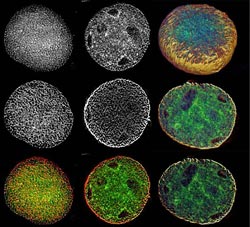Progress in Stem Cell Research based on SLOT

Image of an uncolored aggregate / spheroids from hiPS cells using intrinsic contrast mechanisms with SLOT: Raw data for scattered light (top left) and extinction (middle left) and superposition of both channels (lower left), reconstructed data after filtering the rear projection equivalent to the raw data, rendered image of the superposition of both channels, volume image (top right), in silico cross-section of a 50 µm cut (middle right), and a 15 µm cut (lower right), (the scale bars depict 100 µm).<br>
The goal of the collaborative research project is, for the first time, to use Scanning Laser Optical Tomography (SLOT) for non-invasive, direct, quantitative compilation of the absolute number of cells in cultured, endogenous cell groups.
The results of the project TOMOSphere should bring a better understanding of the physiology of hPSC and other stem cells, as well as a continuous control of their characteristics, making decisive progress in therapeutic concepts possible.
For the investigations, SLOT-technology, which was developed and patented at the LZH, was used for the first time for the temporally and spatially resolved observation of native or fixed cells in three-dimensional aggregate structures. Knowledge gained from using this process can be used to classify and later to sort the aggregates, for example concerning heterogeneity of the cell structure, possible cyst formation, or the deposition of extracellular matrixes.
Furthermore, conclusions concerning important process parameters for the cultivation of aggregates in stirred suspension cultures can be made, such as inoculation densities, the influence of the culture medium, or the maximum or optimal cell and aggregate density per ml of culture medium.
In order to gather this information, the collaborative project is developing an incubation system based on SLOT for tomographic long-term investigations of tissue samples, combined with a wide spectrum of contrast methods. On the one hand, this process should enable marker-free identification of intrinsic cell and tissue specific characteristics, and on the other hand, provide a secondary contrast method using low molecular substances.
For example, with this method, the fluctuation of NAD/NADH, cAMP, Ca2+ ions and their enrichments can be observed, or various states of cell cycles up to a programmed cell death can be verified. Further, it can be used to observe and analyze differential intra- or extracellular agglomerations, or to image different micro- and nanoparticles in cell aggregates.
By using SLOT based, marker-free verification methods for stem cell pluripotency, a higher sensitivity can be reached, especially in comparison to conventional methods. From a technical point of view, a cuvette with cell aggregates is scanned using a needle beam, and a projection image for each scanning position is made from the scattered light, the transmitted light and the fluorescent light. While turning the sample, projections are recorded, and then based on a back projection algorithm, a 3-D data set is generated.
In silico slices can be generated this way, which enable a view deep into the sample material in absence of performing classical histology. Basically, this method can be used to image any isolated and sufficiently transparent sample.
In order to carry out process research and development and controlling on a larger scale, an industrially relevant bioreactor platform with integrated SLOT technology for the mass production of human pluripotent stem cells, and based on this differentiation of cell types, should appear on the market.
Cells resulting from this setup can be used in regenerative medicine, for in vitro modeling of human diseases and illnesses, and for new methods for therapeutic approaches, or for the development of pharmacologically active substances.
The project with a total funding volume of 4.134 Mio. € is part of the “Ultrasensitive Verification and Manipulation of Cells and/or Tissue and their molecular Substances” call for proposals of the German Ministry of Education and Research (BMBF). Apart from the LZH, there are five other partners in the collaborative project (LaVision BioTec/Bielefeld, LEBAO/Hannover, Scivis/Göttingen, Sill Optics/Wendelstein and Miltenyi BioTec/Bergisch Gladbach).
The project started on July 1st, 2013, and the consortium will be funded in the next three years by the BMBF with a total of 2.621 Mio. €.
Contact:
Laser Zentrum Hannover e.V. (LZH)
Lena Bennefeld
Hollerithallee 8
D-30419 Hannover
Tel.: +49 511 2788-238
Fax: +49 511 2788-100
E-Mail: l.bennefeld@lzh.de
The Laser Zentrum Hannover e.V. (LZH) carries out research and development in the field of laser technology and is supported by the Ministry of Economic Affairs, Labour and Transport of the State of Lower Saxony (Niedersächsisches Ministerium für Wirtschaft, Arbeit und Verkehr).
Media Contact
More Information:
http://www.lzh.deAll latest news from the category: Life Sciences and Chemistry
Articles and reports from the Life Sciences and chemistry area deal with applied and basic research into modern biology, chemistry and human medicine.
Valuable information can be found on a range of life sciences fields including bacteriology, biochemistry, bionics, bioinformatics, biophysics, biotechnology, genetics, geobotany, human biology, marine biology, microbiology, molecular biology, cellular biology, zoology, bioinorganic chemistry, microchemistry and environmental chemistry.
Newest articles

Properties of new materials for microchips
… can now be measured well. Reseachers of Delft University of Technology demonstrated measuring performance properties of ultrathin silicon membranes. Making ever smaller and more powerful chips requires new ultrathin…

Floating solar’s potential
… to support sustainable development by addressing climate, water, and energy goals holistically. A new study published this week in Nature Energy raises the potential for floating solar photovoltaics (FPV)…

Skyrmions move at record speeds
… a step towards the computing of the future. An international research team led by scientists from the CNRS1 has discovered that the magnetic nanobubbles2 known as skyrmions can be…





















